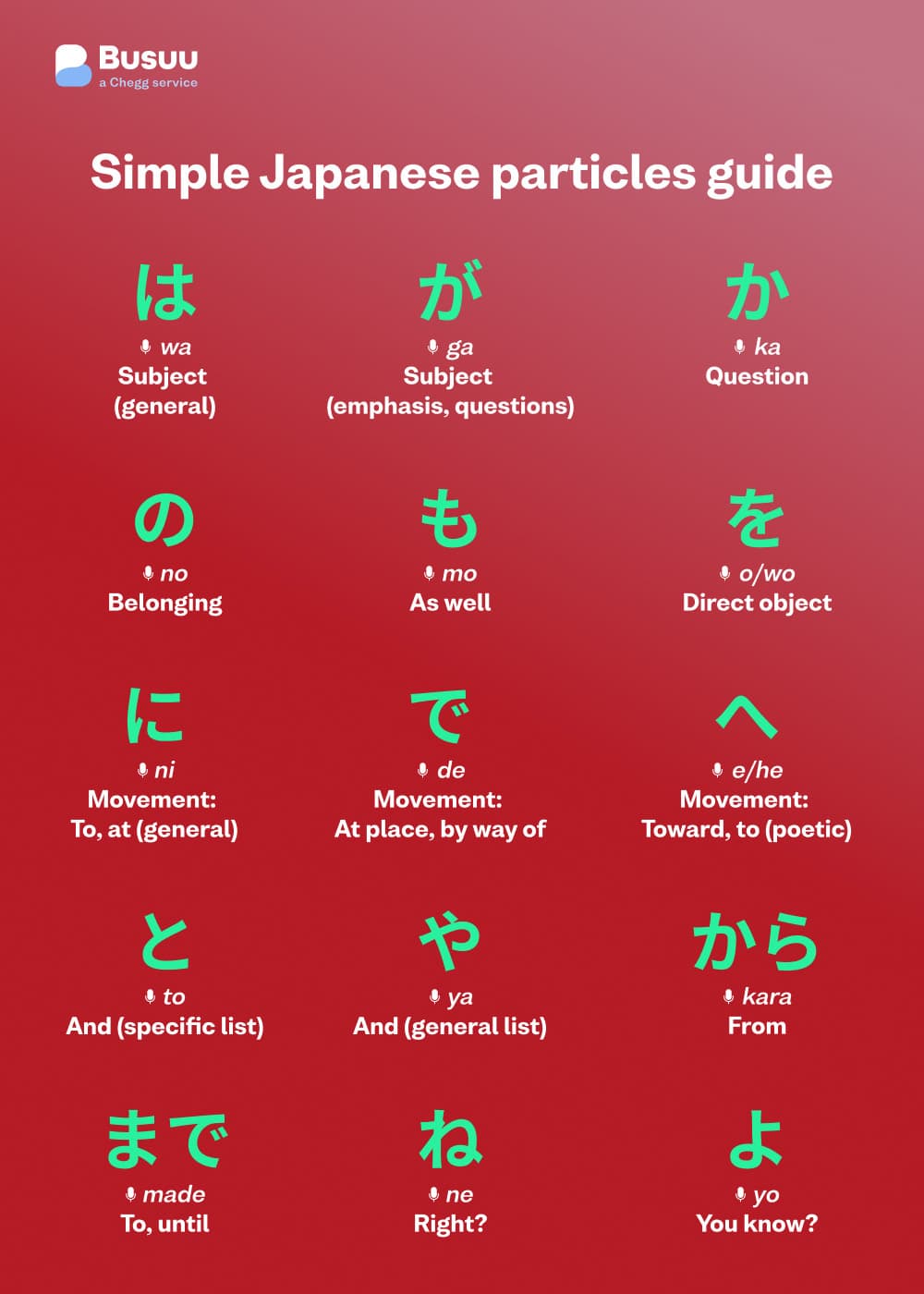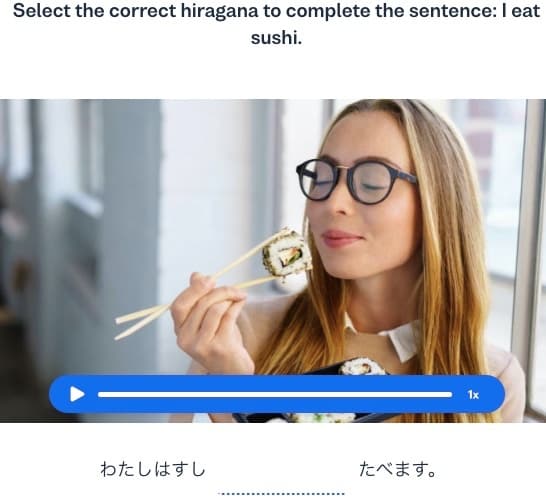I want to learn...
Ready to buckle down and learn Japanese particles? We’re thrilled!
While grammar may not make everyone’s heart skip a beat, it’s incredibly important for communication. If you’re learning Japanese, familiarising yourself with these connector words is essential to getting across your meaning. Fortunately, we have your Japanese particles guide at the ready. We’ll teach you the meaning of ga in Japanese, and words like the ni particle in Japanese.
First, you might be wondering, what are Japanese particles, exactly?
Japanese particles, defined

Japanese particles are function words used to give context to other words. They make a sentence clearer, but they don’t change like verbs or nouns (which can be conjugated or become plural).
English, by and large, uses word order rather than particles to provide context. For example, putting the subject first – think, “Birds eat fish”. Word order tells you what you need to know in that sentence. But we do have some particles.
In Japanese, however, particles are very important. They play a big part in telling you what someone’s talking about, and can function like conjunctions and prepositions – like “in”, “and”, “with”’ or “to”.
In fact, the right particles can make the difference between telling someone you’d love some sushi and recounting a distressing experience:
*“I eat a fish.”
Watashi wa sakana o tabemasu.
わたし は さかな を たべます。
I (←subject) fish (← object) eat“A fish eats me.”
Watashi o sakana wa tabemasu.
わたし を さかな は たべます。
I (← object) fish (←subject) eat
In this case, swapping は (wa) and を (o) creates a big change in meaning.
Fortunately, we’re here to teach you the difference between the basic Japanese particles you need to know.
How many Japanese particles are there?
There are a total of 188 Japanese particles in all! Daunting, maybe, but not something you have to tackle all at once – you’re just getting started, after all.
We’ve put together a list covering some of the most useful and common Japanese particles. While it’s a good start, we’ll be frank – it doesn’t begin to cover all Japanese particles (for that, you’ll have to go through our whole online Japanese course).
So, without further ado, here are your fifteen must-learn Japanese particles explained!
Here’s our handy chart to make it easy to remember the common Japanese particles. If any or all of these are new to you, scroll down – we’ve explained each of them in detail below.
Simple Japanese particles guide
| は wa Subject (general) | がgaSubject (emphasis, questions) | かkaQuestion |
|---|---|---|
| の no Belonging | も mo As well | を o/wo Direct object |
| に ni Movement: To, at (general) | で de Movement: At place, by way of | へ e/he Movement: Toward, to (poetic) |
| と to< And (specific list) | や ya And (general list) | から kara From |
| まで made To, until | ね ne Right? | よ yo You know? |
15 essential Japanese particles list
1. Wa particle in Japanese
Hiragana: は, Romaji: wa
Naomi wa amerikajin desu.
なおみ は アメリカじん です。
“Naomi is an American.”
First, we have wa as a particle in Japanese. は (wa) is used to indicate the subject or actor in a sentence. Here, it tells us that the sentence is about Naomi.
For those who’ve learned hiragana already, it’s worth noting that while は is the symbol for ‘ha’, when used as a particle (as in the example above), it’s always pronounced ‘wa’.
2. Ga particle in Japanese
Hiragana: が, Romaji: ga
Naomi ga amerikajin desu.
なおみ が アメリカじん です。
“Naomi is an American.”
Next, let’s look at ga in Japanese. が (ga) works similarly to は (wa), but is used for comparisons or to refer to a question word (like who, what, where, etc.). In this case, it’s emphasising that Naomi is American – this could be in response to the question, “Which one of you is American?” Or correcting your friend who said that Dan was American. Which he isn’t. Naomi is.
As for question words, what that means is, if your first word was だれ (dare), ‘who’, you would use が (ga) instead of は (wa) to indicate that you’re referring back to ‘who’.
Dare ga kimasu ka.
だれ が 来ます か。
“Who will come?”
Which leads us neatly into our next Japanese particle –ka.
Worth noting: が (ga) can also work like ‘but’, connecting two sentences – but that’s technically called something different: a conjunction particle.
3. Ka particle in Japanese
Hiragana: か, Romaji: ka
Dare ga kimasu ka.
だれ が 来ます か。
“Who will come?”
Third up, we have the Japanese particle ka. Like a question mark, adding か (ka) at the end of a sentence makes that sentence into a question. Simple as that!
Dan wa amerikajin desu ka.
だん は アメリカじん です か。
“Is Dan an American?”
4. No particle in Japanese
Hiragana: の, Romaji: no
Ototo no inu desu.
弟 の いぬ です。
“It’s my little brother’s dog.”
Next, の (no) as a Japanese particle indicates possession. While the word order looks a bit different, it works like ’s (apostrophe s) or of.
Watashi no namae wa Naomi desu.
わたし の なまえ は なおみ です。
“My name is Naomi.”
5. Mo particle in Japanese
Hiragana: も, Romaji: mo
Watashi mo. わたし も。
“Me too.” or “Me also.”
も (_mo), the Japanese particle, primarily means also, too, as well as, but it can also be used to emphasize any, as in:
Nani mo miemasen deshita
何 も 見えませんでした。
“I couldn’t see anything.”
6. O or wo particle in Japanese
Hiragana: を, Romaji: o/wo
Kohi o nomimasu.
コーヒー を 飲みます。
“I drink coffee.”Gohan o tabemasu.
ご飯 を たべます。
“I eat rice.”
As seen in our fish example from earlier (“I eat a fish” vs. “A fish eats me”), を (o) indicates the direct object of a sentence when used as a Japanese particle. We use を (o) only when something is being directly acted upon by the verb.
So if you were to say, “I ate the rice,” you would use を (o). But if you were to say, “The rice was eaten,” you wouldn’t use を (o). Grammar!
7. Ni particle in Japanese
Hiragana: に, Romaji: ni
Nihon ni ikimasu.
日本 に いきます。
“I’m going to Japan.”Juichi-ji ni nemasu.
十一時 に 寝ます。
“I go to bed at 11 o’clock.”Ototo ni inu o agemasu.
弟 に いぬ を 上げます。
“I’m going to give my little brother a dog.”
Next on our Japanese particles list, に (ni) is used to indicate destination, movement, and time, like one word that can mean both to and at. Just think: The knights that say に (ni) are always on the move.
8. De particle in Japanese
Hiragana: で, Romaji: de
Basu de ikimasu.
バス で いきます。
“I went by bus.”Resutoran de sushi o tabemasu.
レストラン で すし を 食べます.
“I eat sushi at a restaurant.”
Another location-related particle, で (de) is used to show context, telling us how or where an action is taking place. It means, loosely, at or by way of.
9. E particle in Japanese
Hiragana: へ, Romaji: e
東京 へ 行きます。
Tokyo e ikimasu.
“I head to Tokyo.”
へ (e) is, as you may know if you’re learned to read hiragana, the symbol for ‘he’. However, it’s pronounced as ‘e’ when used as a particle (just like with は, where ‘ha’ becomes ‘wa’). へ (e) is a lot like に (ni):
東京 へ 行きます。
Tokyo e ikimasu.
and東京 に 行きます。
Tokyo ni ikimasu.
Both basically mean, “I’m going to Tokyo.” But, while に (ni) makes it more of a statement of fact, へ (e) make it more like, “I will travel toward Tokyo.”
へ (e) indicates location and motion, but puts more emphasis on the destination, so it’s more like ‘heading towards’ than simply ‘to’. It’s considered a bit more poetic and nuanced than に (ni), and is also commonly for welcoming someone – it’s the ‘to’ in, “Welcome to my town!”
Worth noting: The particle へ (e) is also often used the way we use ‘dear’ to begin a letter. For example:
きょうこ へ、
Kyoko e,
“Dear Kyoko,”
10. To particle in Japanese
Hiragana: と, Romaji: to
Doresu to karaoke mashin o kōnyū shimashita. ドレス と カラオケマシン を 購入しました。
“I bought a dress and a karaoke machine.”
と (to) means “and” or “with”, and is used specifically to list nouns when you know everything on the list and are saying all the items. So, in the example above, we know that the speaker bought just those two things – a dress and a karaoke machine. Which is all you need, really.
11. Ya particle in Japanese
Hiragana: や, Romaji: ya
Tomu ya Mari wa pati ni imashita.
トム や マリー は パーティー に いました。
“Tom and Marie were at the party.”
Like と (to), や (ya) means “and”, but is used when you don’t know everything on the list or aren’t saying all the items. Sounds like there were other people at the party. Cool!
12. Kara particle in Japanese
Hiragana: から, Romaji: kara
Shigoto kara ie ni kaerimasu.
仕事 から 家 に 帰ります。
“I return to my house from work.”Watashi wa shogo kara gogo san-ji made koko ni imasu.
私 は 正午 から 午後 三時 まで ここ に います。
“I'm here from noon until three pm.”
から (kara) means “from” and can be used both for location and time – so “from 3pm to 6pm” or “from home to school”. から can also mean since or after when used to discuss time. It’s sometimes paired with particle 13 – まで (made) – to say “from X to Y”.
13. Made particle in Japanese
Hiragana: まで , Romaji: made
Pari kara Tōkyō made no kyori wa dorekuraidesu ka?
パリ から 東京 まで の 距離 は どれくらいです か?
“How far is it from Paris to Tokyo?”Watashi wa shogo kara gogo san-ji made koko ni imasu.
私 は 正午 から 午後 三時 まで ここ に います。
“I'm here from noon until 3pm.”
まで (made) means “to” or “until”, and can be used both for location and time – so “from 3pm to 6pm” or “from home to school”. It’s sometimes paired with から (kara) to say “from X to Y”.
14. Ne particle in Japanese
Hiragana: ね, Romaji: ne
今日 は 土曜日 です ね。
Kyou wa doyoubi desu ne.
“Today is Saturday, right?”
Last but not least, we have ね (ne) and よ (yo), which serve the unique function (among these first basic particles, at least) of adding a little flavour to your speech. ね (ne) is added at the end of a sentence and essentially means, “Right?” or, “Isn’t it?” ね (ne) asks the listener whether they agree with what you’re saying, ね.
Learning to use ね (ne) and よ (yo) can help you sound a little more natural when you speak Japanese.
15. Yo particle in Japanese
Hiragana: よ, Romaji: yo
今日 は 土曜日 です よ。
Kyou wa doyoubi desu yo.
“Today is Saturday!” or “Today’s Saturday, you know?”
Similar to ね (ne), よ (yo) goes at the end of a sentence to add a little extra zing to what you’re saying. よ (yo) means something like, “you know?” and can add emphasis or conviction to a sentence, or suggest that you’re sharing new information.
And that’s your first 15 basic Japanese particles explained
Look at that. You’ve learned the 15 most common Japanese particles – go you!
Sure, Japanese particles go far beyond these, but this is a great starting point for learners.
With these words, you can start to decode sentences and make yourself understood. Now all you need to do is remember them… But fear not! We’ve made memorising these particles easy-peasy. Just refer back to the Japanese particles chart at the top of the list any time you’re feeling rusty.
Newlanguages

